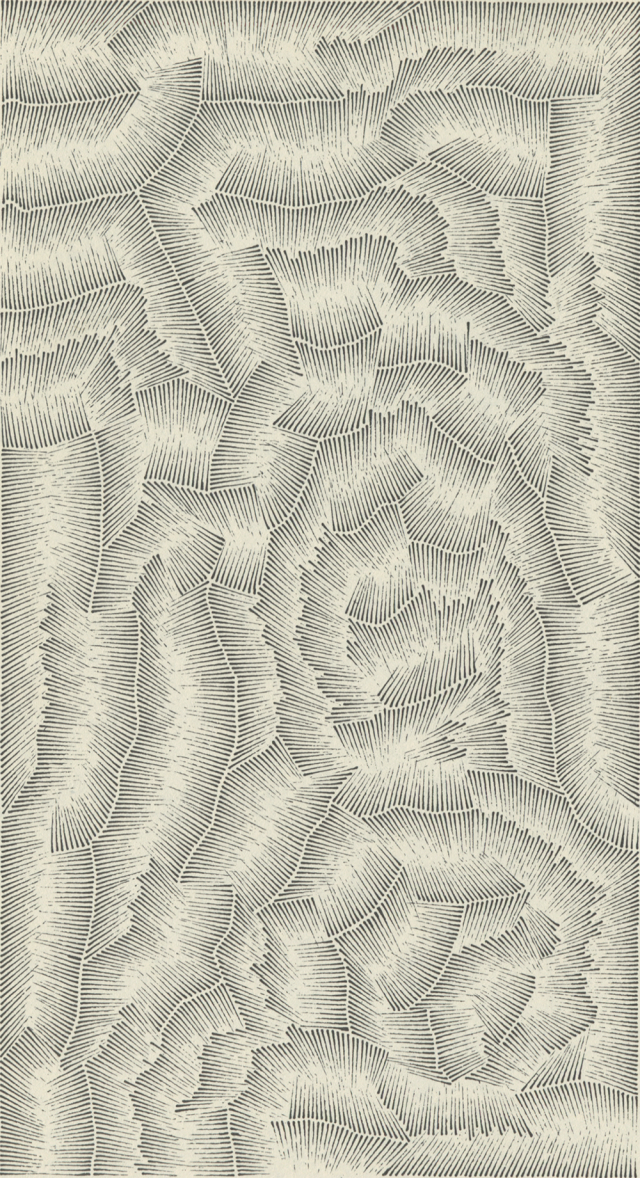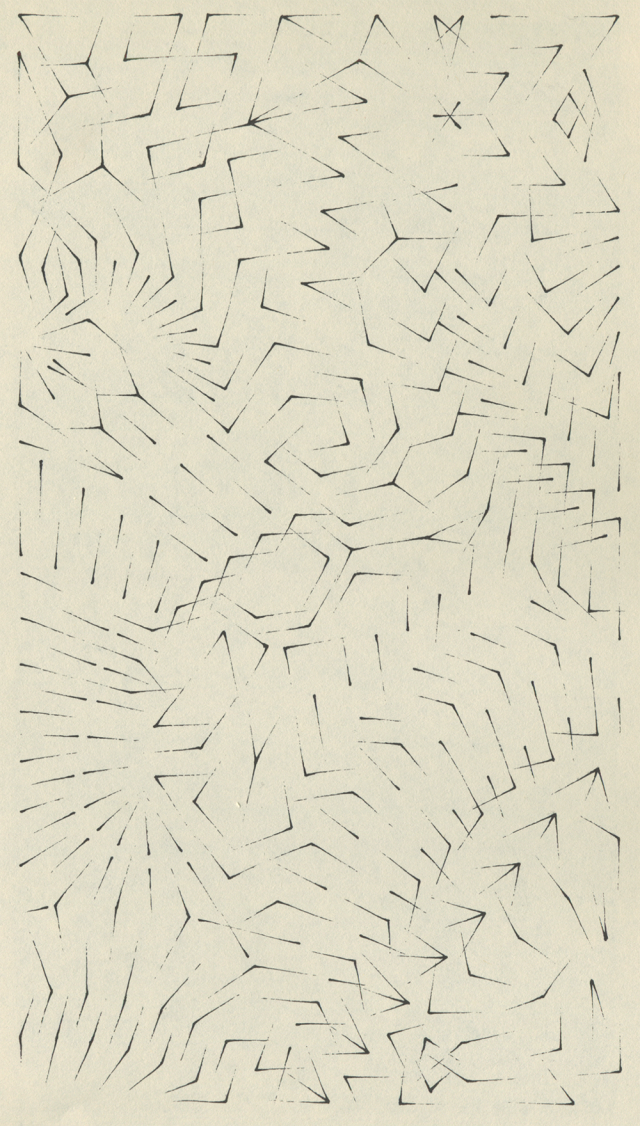Robert Horvttz thinks of his drawing not only as a way of “overcoming genetic inertia” but as a kind of self-discovery . . .“clutching in” to the world. He writes: “Drawing is a metaphor for the self-world relationship. The tip of my pen is the “agent,” the token of my presence in the flat, schematized world of the paper surface. Drawing enables me to model (very rigorously and vividly) many aspects of the self world dialectic; that, in turn, allows me to see deeper into my habits, desires, and capacities, to “try on” different personae in different situations; and that, in turn, leads to gradual and systematic self-optimization—the real fruits of ail this effort.
“The penstroke is made by placing the tip of the pen on the paper and flicking it toward me. The acceleration of the point quickly reduces the amount of ink reaching the paper, so that, in about three-quarters of an inch, it fails to leave any ink at all on the paper. The reason I use this mark, rather than a dot, say, is that I thought it was important that the mark’s gestural aspect be made visually explicit. Otherwise, I wanted it to be the simplest, briefest gesture possible. (This technique was inspired by Planck’s Constant, the smallest quantum of physical energy we know of. Significantly, this unit has the dimensions of an action). I try to make each stroke exactly alike. The only variables are where the stroke begins, the direction it is aimed, and when in a larger series of similar acts it occurs. I discovered almost immediately that the descriptive language imminent in the process is prepositional: between, among, across, toward, after, etc.
“It is possible to draw without any overall plan, but this very quickly gets boring. I am more interested in intentional activity: in positing goals, choosing strategies and “policies of attainment,” taking risks for certain ends, exploring the ramifications of commitments and choices, and so on. Goals may be regarded as positive constraints: “I will do such-and-such.” There are also negative constraints: “I will not do such-and-such.” There are, in between, degrees of constraint: “I may do such-and-such under such-and-such conditions”; “I will avoid doing such-and-such, unless it enables me to do such-and-such later on.” Constraints come not only with degrees of strictness/looseness, but with different priority, so that when a conflict arises, and two constraints cannot be honored simultaneously, one yields to the other. There are constraints on the applications of other constraints. Thus, it is possible to work out hierarchies of obligation, positive and negative, that govern the choices I make in the process of drawing, without entirely eliminating free choice. And 1 hope it is clear that not all of the constraints I work under are formal. Actually, the more specific and formal a constraint is, the smaller its range of application is. Very general constraints can exert a pervasive influence, even though they do not directly require any specific action. For instance, the core of my work is a series I call ’ ’The Dialectics of Drawing” which I have been working on since 1970. Each step in the progression must fulfill two major constraints: 1) each drawing must either introduce an important principle that had not appeared in any previous drawing, or introduce a new interpretation of an old principle so significant that it would otherwise qualify as a new principal; and 2) each drawing must be such that if I were to die right after finishing it, I would be happy that it had been my last drawing. As you can see, the application of constraints often requires a great deal of interpretation and personal judgment. Thus, the use of systematic constraint does not eliminate intuition at all. It rather organizes it and gives it a quasi-legal consistency.
“Having worked with this method for about eight years, I have recently focussed on some aspects that would surely seem esoteric to anyone else. Working out interesting systems or heirarchies of constraint is no longer what I concentrate on. The constraints themselves are actually of very little interest anyway: they just provide the framework for exploring the more subtle patterns of choice, preference, curiosity that energize my attention in an otherwise unexaminable, ongoing flux. I’m now involved with a series of questions raised by the discovery, three years ago, of the problem of “invisible violations,” of violations of constraints done in such a way that evidence for the violation is destroyed in the act of violation itself. This points up the previously unexplored problem of internal conflicts of interest: Who judges compliance with the constraints? I do. But I am also the perpetrator and the legislator. If the evidence is destroyed, how can a violation be “prosecuted,” especially when the “judge” is prejudiced by being an internalized conscience of the perpetrator. I am beginning to realize the benefits, {but also the limits) of having “outside observers,” that is, an audience looking over my shoulder. The viewer-who-is-not-me often represents the next higher court of appeal. (This should really be the subject of a longer, separate essay.) Really what I’m involved with now is the gap between private knowledge and public evidence.
“At any rate, all this should indicate that I am much more preoccupied with the process of drawing than the product, and with the personal uses of the experience than with the public’s access. Whenever I have encountered a conflict between making the work more accessible to others and making it more intense and relevant to myself I have always chosen the latter. Recently I read an essay by Lucy Lippard where she claims that “a work of art that doesn’t communicate is a very poor work of art.” I’m prepared to accept that verdict. I make no claim that what I do has artistic value. But I will argue that what I do has profound personal value. Amazingly enough, though, I have found that certain aspects of my experience are communicated accurately, if inadvertently, through the appearance of the drawings. A few people have read them so clearly that I have felt embarassment at having exposed so much of myself, in general, though, I make no effort to be either explicit or obscure about what I’m doing; the fact that my drawmgs have been accurately interpreted by others does reassure me that I am tapped into some concerns that are not just personal, they’re human.”





